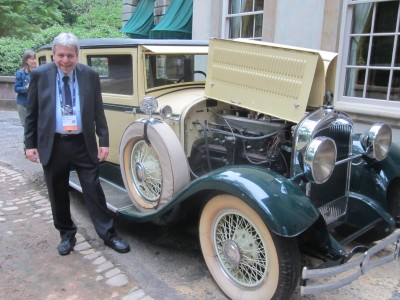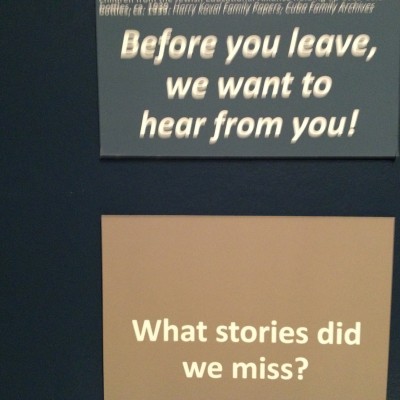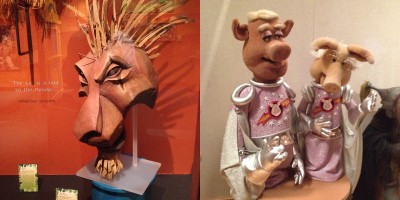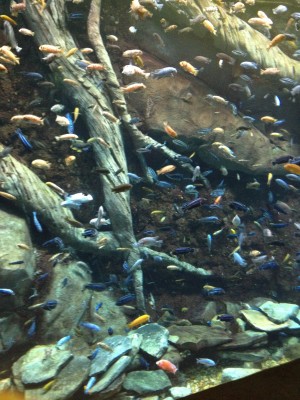Report from Atlanta
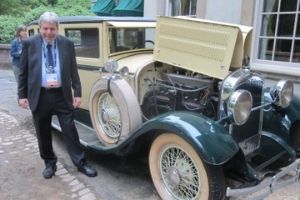
A blog post by Museum Director Marvin Pinkert. To read more posts from Marvin click HERE.
I can still remember the odd feeling in 1968 watching the split screen of the events inside and outside the Democratic Convention in Chicago. I was 16 at the time. The events on TV were made a bit stranger since a few of my friends and relatives were in the streets that day (just 12 miles from my home) being tear-gassed and beaten while I was under my mother’s orders not to leave the house.
All those feelings from 1968 came back to me as I sat helplessly in my hotel room at the AAM museum conference in Atlanta watching parts of my adopted city burn. The conference theme was “the social value of museums inspiring change” – all I could think was “we have a lot of work ahead.”
I am writing this blog post about what was on “the other half of my screen” – the half that was doing my darndest to focus on ideas that might be useful to either adopt, adapt or avoid at JMM.
In conjunction with the conference I had a chance to visit four Atlanta museums I had not seen before and revisit the Atlanta History Center. Let me share a few personal observations about these five institutions.
- This was my second trip to the Atlanta History Center which is undergoing a major renovation. But their “unique” Civil War exhibit is still open to the public – if you want to know the Confederacy’s “strategy to win the war in 1865”, this is definitely the place to come. It also offered a fabulous dessert bar as part of a progressive dinner (sorry, no picture) – I lost that battle too! But here is a photo of me with a 1929 Hudson Super Six Sedan that made me feel like I was on the set of Downton Abbey – the grounds of the History Center are among the most beautiful settings for a museum that I’ve ever seen.
- The William Breman Jewish Heritage and Holocaust Museum. The museum has five major spaces on the ground floor (as well as quite a large surface parking lot). Two spaces are for performance/activities: a small theater and a much larger auditorium (The Selig Center) which appears to be a shared use space with Atlanta’s Jewish Federation. There is a permanent Holocaust gallery – heavily photo based; a temporary exhibit gallery (about the size of ours – currently featuring a tribute to Maurice Sendak); and a core exhibit, organized as a chronological journey through major artifacts from the collection. I found the most interesting part of this gallery was the invitation at its end for visitor’s to offer their ideas of “missing topics” … I’ll be interested in finding out what kind of response rate they are getting to this offer.
- The Center for Puppetry Arts is located directly across the street from the Breman Museum. My sense is that this makes a great combination for attracting both family audiences and school groups – that can easily see both museums in the same day. Puppetry Arts (an inspiration of the Henson family kids) is in the midst of a significant expansion. For now, I was most impressed with the diversity of artifacts on display representing everything from Balinese shadow puppets to Julie Taymor’s Lion King costumes to Pigs in Space. Label copy and curatorial work is rather homespun but it is a space with lots of potential.
- Georgia Aquarium has an incredible array of animals and environments. Each tank is so full of biodiversity that it seems to scream – “you will never figure out everything that’s here.” The space makes use of lots of artificial environments and even fantasy to stimulate popular interest. It is bright, bold and perhaps a bit corporate.
- College Football Hall of Fame – Atlanta’s newest attraction – makes the Aquarium seem sedate. There is absolutely no line here between corporate sponsorship, product placement and exhibit content… even the logo has ad type in it. Your first on-screen guide in the exhibit is the cow from the Chick-fil-a ad campaign. The flashing screens and interactives are numerous and overlapping. The signature technology is a badge you are given that “personalizes” your visit by recognizing your favorite college team and customizing the interactives to match the colors, mascot, song etc. of your alma mater (more exciting I think for someone who went to Michigan than to Brandeis). And perhaps the bottom line is that this is a museum for people who would normally not be caught dead in a museum – and that may be an astute assessment of the market.
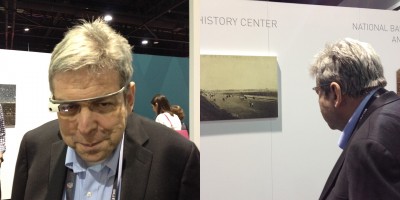
Speaking of technology – a lot of what’s new in the museum world can be found on the Museum Expo floor. It is always fun trying out the latest gadgets. Above you see me as a newbie to Google Glass. The demonstration was designed to show that you could add a layer of content to a piece of art or old photograph on a very cool display. My personal impression – the best part was being able to say “look at me wearing this great piece of technology”. The content was underwhelming and who really thinks they want to have content sitting in their field of view – between you and the historic object. Most of us want to get closer to something authentic, not have a layer that pushes us away.
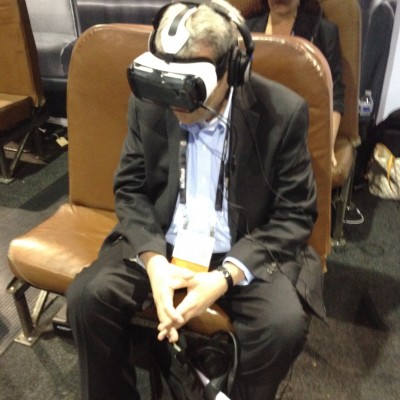
My assessment of this very heavy set of immersive virtual reality glasses is not much better. The content in this case was a first person perspective of Rosa Parks on the bus – as the bus driver and then a policeman get in your face. The glasses allow you to look at the people behind you when you are being accosted – not sure that this is an “enhancement”. Like the Google Glass these units are also a significant problem to maintain, as (for hygiene reasons) they need to be cleaned after every use.
But I don’t want you to think I am a complete Luddite. There were two more modest pieces of hardware/software that really got me thinking. The first were small display cases with thin LED projection surfaces on the front. This case would allow you to “animate” the label copy superimposed on an object in a protected case. No special glasses required and the price of the case is very competitive with other types of protective structures. Two companies had prototypes on display.
The most impressive technology I saw was this simple (and almost free) telepresence system: http://www.venturerobotics.com/
Look at this for a moment and think of what it might mean for providing visitors access to spaces with physical barriers like the Lloyd Street Synagogue or environments with security concerns like vault space or access for global visitors. Definitely going to begin a conversation here. The expo provided proof, if any was needed, that the value of a gizmo is not to be found in its sleekness, complexity or price tag but rather the quality of the thought process about how it will be used.
By now you may be wondering – did you just spend your time visiting museums, touring technologies and making new contacts for JMM. Well mostly… but I did spend some time at panels and in sessions that inspired fresh thinking about our work at JMM. Especially useful were sessions on marketing, membership and recent psychographic studies of museum visitors’ interests. I also attended a session entitled “Missouri Burning” about the response of the Missouri State Historical Society in St. Louis to the events in neighboring Ferguson. If I had to describe this conference in one word – I think I would pick “timely.”
It was a week I needed some perspective and AAM gave me a full year’s supply.
~Marvin

